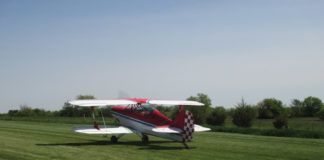With many builders opting for all-electronic flight displays, the life cycle of the venerable vacuum system might be nearing an end. After all, there must be better ways to power attitude instruments than sucking air through them, right? Well, maybe. But the fact remains that a lot of builders continue to opt for vacuum systems in their homebuilts, even if they are used only to power backup instruments. There are certainly many currently flying homebuilts using this technology.
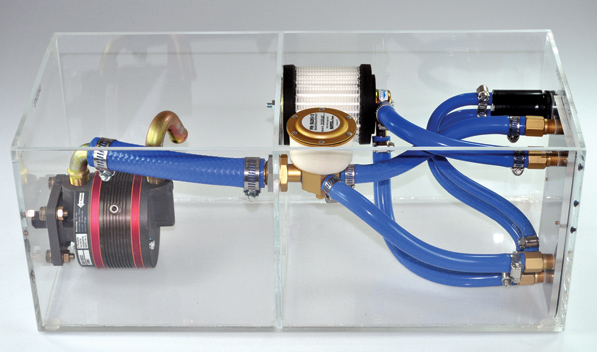
The vacuum system in miniature, sort of. Pump on the left, regulator and inlet filter in the center. Note the proper curved fittings on the vacuum pump.
Air-driven instruments have the benefit of being light and inexpensive, characteristics that the airframe manufacturers loved so much that they adopted vacuum instruments across the board. The weak link in this chain has always been the engine-driven vacuum pump, which has caused the reliability of the entire system to be less than desirable. In particular, the dry vacuum pump is often called on the carpet for a short and unpredictable service life. (Its predecessor, the wet vacuum pump, used engine oil ported through the drive pad to lubricate the working parts of the pump, giving it long life. Unfortunately, the wet pump was heavy and messy, requiring a separator on the outlet to keep oil mist under control.)
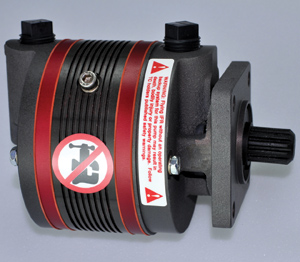
The traditional dry vacuum pump.
Pump House
The major components of a dry air pump are a metal body, a carbon-graphite or aluminum rotor and a series of hard carbon vanes that slide freely in slots cut in the rotor. The inner walls of the body form an elliptical chamber. As the rotor turns, the vanes are forced outward against the walls of the chamber by centrifugal force and continually slide in and out in the vane slots. The carbon in the rotor and vanes acts as the lubricant.
The rotor is connected through a frangible coupling to a drive gear that meshes with an engine accessory drive gear. The connection is incorporated to protect the engine from damage should the pump seize.
Gyros in a dry-pump system require the air being drawn into the instrument case to have a (negative) pressure of between 4.5 and 5.2 inches of mercury (in. Hg.); 5 inches of mercury is equivalent to 2.5 psi. One estimate of the volume of air required to drive a typical attitude indicator and directional gyro is between 3.6 and 4 cubic feet per minute. In other words, dry air pumps must move large volumes of air at relatively low pressures. As long as dirt is kept out and air flows freely through the system, the pumps can be dependable. Under design conditions every pump on the market is capable of supplying vacuum at altitudes up above 20,000 feet.
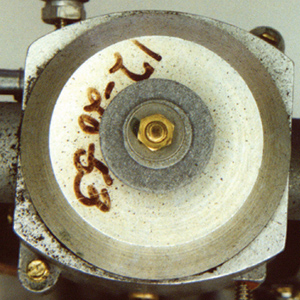
Carbon particles will contaminate delicate gyro instruments during a carbon blowback if it’s serious.
Performing adequately at this high volume/low pressure and at altitude is not an easy task. As a necessity, the clearance between the inner walls of new dry air pumps and the rotors has to be tight-on the order of 0.004 inch-for the pump to be efficient and to compensate for wear over the expected life of the pump. During normal operation of the pump the housing expands due to engine heat radiating to the pump body and to the heat generated within the pump as it compresses air. The sliding vanes automatically compensate for this.
Vanes wear on one side in what is called "vane flank wear." The vane slots in the rotor are canted to counteract this wear. The vane canting is reflected in the clockwise (CW) and counter-clockwise (CC) labeling. Any increase in pump outlet pressures increases vane flank wear, which weakens the vanes and will eventually cause them to break. Vanes also break if they get too short, which allows them to cock in the rotor slots. Pump manufacturers now incorporate removable ports that allow technicians and aircraft owners to conduct periodic vane wear measurements.
During operation, carbon is worn from the vanes. Most of this carbon dust is exhausted, but there’s always a fine coating in every pump. All pump makers know about this wear and provide extra pumping capacity to compensate for the loss of pump efficiency that it causes.
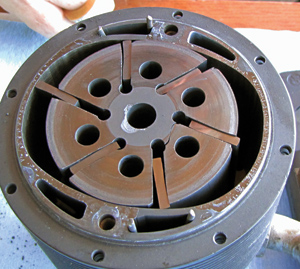
This 400-series pump failed during day/VFR flight. The rotor and two of the vanes fractured. The pump had previously been rebuilt by the aircraft owner using a pump rebuild kit.
Failed Again
One big knock against dry air pumps is the failure mode, which is sudden and unpredictable. By contrast, the old wet pumps tended to deteriorate gradually, giving the owner/pilot reasonable warning and time to replace the pump. One moment the instruments powered by the pump are stable and dependable due to the steady stream of filtered air being directed onto the instrument rotors, and the next minute the pump seizes, the connection breaks and airflow ceases.
Unless pilots detect the pump failure immediately, they will soon be sliding down a slippery slope toward loss of control as the gyros gradually begin precessing-providing bogus attitude and directional data-as the rotors slow. It’s vitally important that every gyro system incorporate a loss-of-vacuum warning light or flag to prevent loss-of-control accidents. Precise Flight sells a standalone low-vacuum warning light; Rapco, Inc. makes a vacuum system regulator with the provision for a screw-in pressure-sensing switch; and many instruments have low-vacuum warning flags that drop across the instrument face field of view after pump failure.
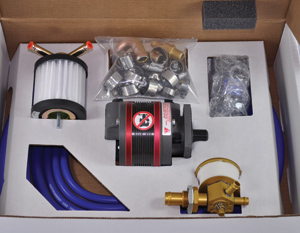
Rapco’s full instrument kit includes a pump, regulator, filter, fittings and hoses.
Just a Bad Rep?
The vacuum pump as an unreliable device is not a universal opinion, however. Ralph Heysek, an engineer who set up a test lab for Airborne’s pneumatic division and spent 17 years working with dry air pumps, says that dry air pump systems are so dependable that they will last 900 hours. But Heysek’s assertion comes with a caveat-the system must not leak, and the pump must be set up correctly. Heysek says the only way to get the results he claims are possible is to test the system, not by running it on the ground, but by using a test box.
"The only thing you’re testing by running a vacuum pump system on the ground is that the needle hasn’t fallen off the gauge," says Heysek. A proper test is to see if a vacuum of 6.5 in. Hg. applied to the pump end of the hose from the firewall-mounted regulator results in a 5.0 in. Hg. reading on the system gauge on the instrument panel. The AeroTech Products CV-7000 test kit is ideal for this test (cost is less than $600), but any pump that can provide slightly more than 3 psi (6.5 in. Hg. = 3.2 psi) of vacuum will work.
A leaky system or a restricted system causes pumps to heat up. This opens up critical clearances, causing pump internal leakage. Heat shortens pump life. Heysek insists that the key to pump longevity and dependability is a leak-free system. In a healthy system, the pump will need to draw no more than 6.5 in. Hg. to produce the 5.0 in. Hg. required to maintain system function.
If this test doesn’t result in a 5.0 in. Hg. reading at the gauge, it’s time to start the leak search. In all things maintenance, begin with the easiest approach to fixing the problem and then retest. Remove the filter at the inlet end of the system. Retest. No? Tighten the system clamps next. Now is a good time to throw away all the spring-type clamps that were used in the system, and replace them with screw-type clamps similar to the AeroSeal QS 200. Test again. If tightening and new clamps don’t slow the leakage, then start changing hoses. The hoses most likely to leak are those that are hardest to get to. These are the hoses up under the instrument panel between the cabin side of the regulator and the individual instruments including the gauge. Mooney specifies Mil-H 5593 hose, also known in the field as Aeroquip 306. It can be bought by the foot at any aero supply house. Work diligently to keep the hoses clean during installation, remembering always that dirt and debris destroy dry air pumps.
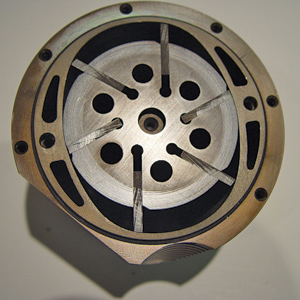
In this view the rotor will turn counter-clockwise. The elliptical shape of the chamber can be seen. The four elongated triangular shaped holes outboard of the chamber are the air inlet and outlets. The left upper hole is pressure out; left lower is air inlet; right lower is pressure out and right upper is an air inlet.
Proper Care and Feeding
When a pump fails it’s usually because of wear, contamination or excessive heat. A failure almost always causes a major fracturing of both rotors and vanes, creating an additional storm of carbon dust and an instantaneous loss of vacuum. In most cases the failure is severe enough to destroy the seal-created by the close tolerances between the rotor and housing and the contact of the vanes with the elliptical inner walls of the housing-between the ram high air pressure under the cowling at the pump exhaust and the low pressure air in the vacuum system. The high pressure air rushes through the pump body into the hoses and the regulator and in some cases all the way to the DG and AH. Mounted between the pump and the gyros, the $100 AeroTech Components ClearView filter catches carbon dust before it gets to the instruments. The filter housing is clear and allows technicians and owners to inspect for the presence of carbon dust.
You can make any dry air pump fail: Spray mineral spirits or other engine cleaning liquids in the vicinity of an unprotected dry air pump. The second the pump begins rotating, vapors from the liquids are drawn into the pump and mix with the existing carbon dust to form pump-seizing gunk. Always cover dry air pumps and the vacuum system regulators with a thorough wrapping of plastic bags or aluminum foil whenever mineral spirits or other cleaning liquids are being sprayed around the engine.
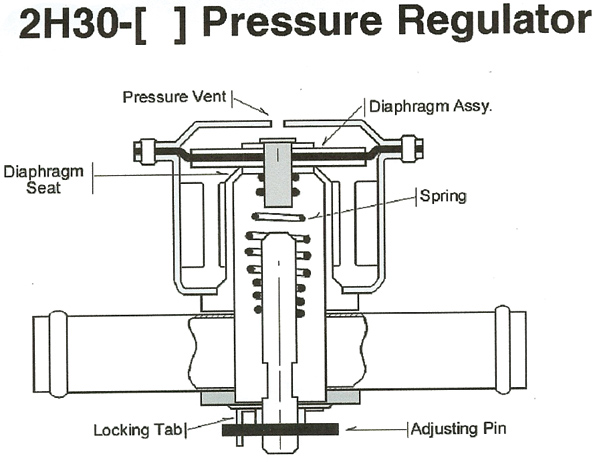
Vacuum is vented to lower side of diaphragm; the upper side is vented to atmospheric pressure. Changes in the vacuum move the diaphragm, varying the position of a needle relative to a seat. In addition to varying the amount of atmospheric pressure being drawn into the suction hose, this also makes adjustments for changes in atmospheric pressure.
The following steps must be observed when installing a new pump. Install only low-restriction type fittings in the pump (both Aero Accessories and Rapco sell them). Do not use any other type of fittings. Lubricate fitting threads with silicone spray only-no Teflon tape or pipe dope. Clamp the pump by the base flange only when installing fittings; never clamp the pump body.
If you drop the pump, do not install it. During installation, install a new gasket and tighten the mounting nuts to a maximum of 70 inch-pounds (6 foot-pounds).
The bottom line: Vacuum-driven gyro instrument systems are dependable if they are set up correctly and are well-maintained. Ongoing maintenance and general engine-compartment care will help prolong the life of any dry air vacuum pump.

![]()
Steve Ells is what you call a gen-u-ine mechanic, a bonafide A&P with an Inspection Authorization. Former West Coast editor for AOPA Pilot and tech guy for the Cessna Pilots Association, Ells has flown and wrenched on a wide range of aircraft. He owns and wrenches (a lot!) on a classic Piper Comanche. But don’t hold that against him.










